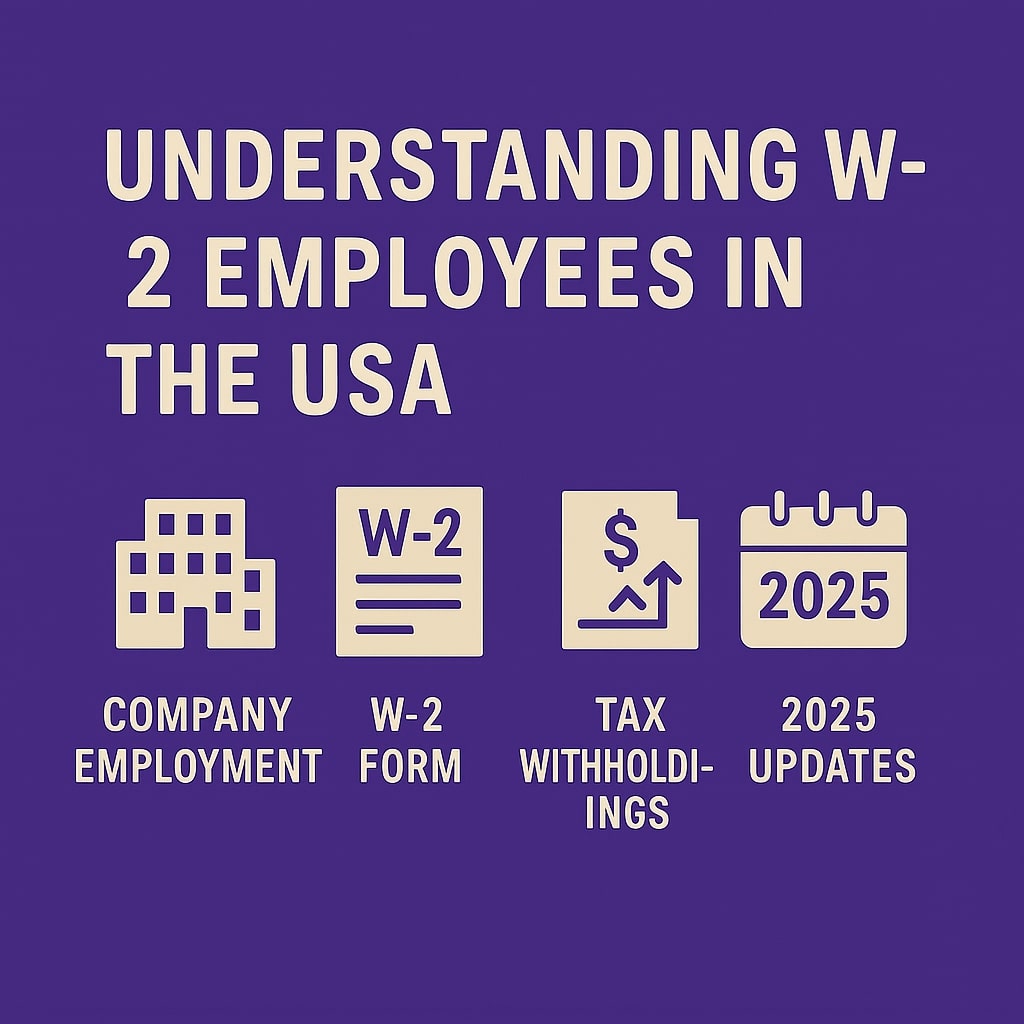In the United States, the W-2 employee, unlike the 1099 employee, is someone who works for an employer and receives a Form W-2, which details their earnings and the taxes withheld. This status is essential for both employers and employees as it governs taxes, benefits, and compliance obligations. With several changes impacting W-2 regulations in 2025, including tax adjustments, overtime eligibility expansions, and retirement benefit updates, employers and employees should be aware of new requirements.
What is a W-2 Employee?
A W-2 employee is formally employed by a U.S.-based company or organization. They are classified as employees (not independent contractors or freelancers), receive regular wages, and benefit from legal protections under U.S. employment laws. Key characteristics include:
- Employer-Employee Relationship: W-2 employees have a formal contract and their work is directed by the employer.
- Regular Wages and Benefits: They receive a consistent salary or hourly wage, often with benefits like health insurance, paid time off, and retirement contributions.
- Tax Withholdings: Employers withhold income taxes, Social Security, and Medicare from employee paychecks and remit these to the government.
- W-2 Form: Each January, employees receive a W-2 form, which details their total earnings and tax withholdings, essential for filing their annual tax return.
Form W-2: Essential Tax Document for Employees
Form W-2, also known as the Wage and Tax Statement, reports an employee’s total earnings and tax withholdings. Employers are required to provide a W-2 form to each employee by January 31 annually. Here’s a breakdown of W-2 copies and their uses:
- Copy A: Sent to the Social Security Administration (SSA).
- Copy B: For the employee’s federal tax return.
- Copy C: Retained by the employee for personal records.
- Copy D: Kept by the employer for their records.
- Copy 1: Filed with state, city, or local agencies if required.
- Copy 2: Submitted to the employee’s state or local tax authorities.
Employees may sometimes receive multiple W-2 forms from a single employer, usually due to mergers or a change in employer identification numbers (EINs). In such cases, check with the employer to confirm accuracy. If multiple W-2s are received from different employers, employees must file each one on their tax return.
If an employee does not receive their W-2 by the deadline, they can contact the IRS for assistance in obtaining a copy.
W-2 Benefits: What Employees Can Expect
One advantage of W-2 employment is access to various benefits and protections. These benefits include:
- Mandatory Benefits:
- FICA Taxes: Coverage for Social Security and Medicare.
- Unemployment Insurance: Funded by employers to provide income support during periods of job loss.
- Workers’ Compensation: Coverage for workplace injuries and illnesses.
- Family and Medical Leave Act (FMLA): Provides job-protected unpaid leave for qualifying family and medical reasons.
- Optional Benefits (may vary by employer):
- Health Insurance: Employers may offer health, dental, and vision insurance.
- Retirement Plans: Contributions to 401(k) or pension plans, sometimes with employer matching.
- Paid Time Off: Vacation days, sick leave, and other paid leave.
- Disability Insurance: Short-term or long-term income protection for injury or illness.
These benefits, which contractors typically do not receive, contribute to greater job security and financial stability for W-2 employees.
How Recent Laws Impact W-2 Employees in 2025
Tax Adjustments
The IRS has implemented several inflation-based adjustments for the 2025 tax year:
- Standard Deduction Increase: Single filers will see the deduction rise to $15,000, while married couples filing jointly will have a $30,000 deduction IRS NerdWallet: Finance smarter.
- Income Tax Bracket Adjustments: Although the top tax rate remains at 37%, income thresholds for all brackets have been raised, affecting tax withholding rates for employees IRS.
W-2 employees should consider updating their W-4 form elections to reflect these changes, ensuring accurate tax withholdings throughout the year.
Overtime Regulation Update
A significant change to the Fair Labor Standards Act (FLSA) overtime rules is set to take effect on January 1, 2025. Under this update:
- Most salaried employees earning less than $1,128 per week will qualify for overtime pay if they work over 40 hours in a week.
- The threshold for highly compensated employees will increase to $151,164 annually, ensuring that more salaried workers are eligible for overtime protections.
- Starting in 2027, the salary thresholds will be adjusted every three years to reflect wage changes
Employers should review and update their payroll systems to ensure compliance, while eligible employees should confirm their overtime entitlements.
SECURE 2.0 Act and Retirement Contributions
The SECURE 2.0 Act introduces several provisions that may impact W-2 employees’ retirement savings options:
- De Minimis Incentives for Retirement Plan Participation: Employers can now offer small financial incentives to encourage employees to participate in 401(k) or 403(b) plans. Any incentives are subject to standard income tax withholding and should be included on the W-2
IRS.
- Roth SIMPLE and SEP IRAs: Employers offering SIMPLE or SEP IRA options can allow employees to designate Roth IRAs for contributions. These contributions, as well as employer-matching Roth contributions, will be reported on W-2 forms IRS.
These provisions aim to boost retirement savings while ensuring transparency in income reporting.
W-2 Equivalent for Non-US Employees
W-2 forms apply to U.S.-based employees. For foreign employees working for U.S. companies, Form 1042-S may apply, which reports U.S. source income for non-residents. Non-resident employees working remotely for U.S. companies should typically pay taxes in their home country. However, if a tax treaty exists between the U.S. and the employee’s country, double taxation may be avoided. Employees should verify local tax obligations and whether their income is subject to U.S. withholding.
Conclusion
The upcoming 2025 changes for W-2 employees, from tax bracket updates to overtime eligibility expansions and revised retirement reporting, reflect ongoing adjustments to support fair wages and transparent tax practices. By staying informed and proactive, both W-2 employees and employers can ensure compliance and benefit from these evolving protections.

